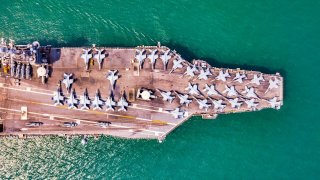Turkey: The Next Aircraft Carrier Superpower?
NATO ally Turkey could become the latest nation to operate aircraft carriers.
Summary: Turkey is advancing its naval capabilities by developing its second aircraft carrier, following the commissioning of the TCG Anadolu, a multipurpose amphibious assault ship, into the Turkish Navy.
-Modeled after Spain’s Juan Carlos I but with significant domestic production, the TCG Anadolu represents a step towards greater naval autonomy for Turkey.
-The new carrier, which will be entirely domestically designed and built, aims to further demonstrate Turkey's self-reliance in naval construction. This upcoming vessel will feature three runways and initially use a modular ramp system, with plans to develop an indigenous catapult system. Designed to support a mix of manned and unmanned aerial vehicles, the carrier will have a significant airwing capacity and be equipped with advanced defensive systems, emphasizing Turkey’s commitment to expanding its maritime strength and capabilities.
Turkey Advances Naval Power with Plans for Second Domestically Built Aircraft Carrier
NATO ally Turkey could become the latest nation to operate aircraft carriers—and this month, the Turkish Navy’s Istanbul Naval Shipyard revealed the latest developments of its future flattop. This clarified the confusion that this new warship was the second landing helicopter dock (LHD).
It was last year that the TCG Anadolu multipurpose amphibious assault ship was commissioned into the Turkish Navy. That warship was modeled after Spain’s Juan Carlos I LHD but was built with 70 percent domestic production. According to Turkish officials, a team of some 110 individuals at the Directorate of Design Project Office (DPO) is already exploring ways to increase the domestic production ratio for the new national aircraft carrier.
Turkey’s First Carrier
Designed to be the Turkish Navy’s new flagship, the multipurpose amphibious assault ship TCG Anadolu (Turkish for the Anatolian peninsula) was also meant to represent the “Century of Türkiye,” President Recep Tayyip Erdogan said at a ceremony last April, adding, “The TCG Anadolu ... is the world’s first warship in its field where UAVs can land and take off.”
The TCG Anadolu measures 231 meters (758 feet) in length and 32 meters in width, while it has a displacement of 27,436 tons. It was ordered in 2015 and launched in April 2019. However, its inauguration, initially planned for 2021, was delayed due to the COVID-19 pandemic. It was officially commissioned in the ceremony on April 10, 2023.
She can reach a top speed of 21 knots and a range of 9,000 nautical miles, with an endurance of fifty days at sea. The warship can carry 1,400 personnel—a battalion of soldiers/marines, along with combat vehicles and support equipment.
The TCG Anadolu was originally intended to support helicopters and short takeoff and vertical landing (STOVL) fighters, notably the Lockheed Martin F-35B Lightning II, but the flattop’s role evolved following Turkey’s expulsion from the F-35 program in 2019 due to the acquisition of Russian-made S-400 air defense systems.
Turkey’s Aircraft Carriers: Something Bigger?
At a January 3, 2024, meeting of the Turkish Defense Industry Executive Committee, Erdogan gave the green light for a second carrier, while plans were approved for the construction of the M LGEM 9-10-11-12th ships (I-class frigates), offshore patrol vessels, new types of landing ships, and new generation minehunters.
Details are now emerging about the second carrier. The DPO has said it will not receive any support from a foreign country in its design and construction. Instead, it will be built entirely domestically, showcasing Turkey’s self-reliance in this significant naval project.
Early designs suggest it will include three runways, with two designated for takeoff and one for landing purposes. Initially, there will be no catapult system onboard, and instead, the DPO has called for a modular ramp—while the long-term plan involves the development of an indigenous catapult system by Turkish engineers.
Moreover, the current plans call for the carrier to support an airwing of fifty aircraft, with twenty to be stationed on the deck and thirty more housed in the hangar. It is envisaged that both manned and unmanned aerial vehicles (UAVs) of domestic origin will be deployed on the new aircraft carrier.
Among these aircraft are the naval version of TAI’s Hurjet light attack aircraft, TAI ANKA-III unmanned jet fighter, Baykar’s Bayraktar KIZILELMA unmanned jet fighter, and TB-3 UCAV. According to Defence Turkey, Turkish defense officials have indicated that the number of aircraft may be increased as the project progresses. DPO is in touch with TAI and Baykar for the project, NavalNews.com reported.
The domestically-built Turkish carrier could be reasonably armed, with a 32-cell MIDLAS VLS (Vertical Launching System), and four Gökdeniz Close-in Weapon systems for self-defense.
The design calls for it to be 285 meters (935 feet) in length with a displacement of 60,000 tons. Additionally, the carrier will be equipped with Combined Gas Turbine and Gas Turbine (COGAG) propulsion, ensuring a maximum speed of 25 knots.
Author Experience and Expertise: Peter Suciu
Peter Suciu is a Michigan-based writer. He has contributed to more than four dozen magazines, newspapers, and websites with over 3,200 published pieces over a twenty-year career in journalism. He regularly writes about military hardware, firearms history, cybersecurity, politics, and international affairs. Peter is also a Contributing Writer for Forbes and Clearance Jobs. You can follow him on Twitter: @PeterSuciu. You can email the author: [email protected].


